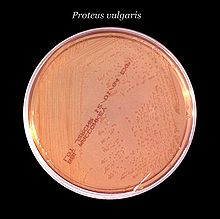You can help expand this article with text translated from the corresponding article in German. (January 2022) Click [show] for important translation instructions.
|
| Proteus | |
|---|---|

| |
| Proteus vulgaris growth in MacConkey agar culture plate | |
| Scientific classification | |
| Domain: | Bacteria |
| Phylum: | Pseudomonadota |
| Class: | Gammaproteobacteria |
| Order: | Enterobacterales |
| Family: | Enterobacteriaceae |
| Genus: | Proteus Hauser, 1885 |
| Species | |
Proteus is a genus of Gram-negative bacteria. It is a rod shaped, aerobic and motile bacteria, which is able to migrate across surfaces due its “swarming” characteristic in temperatures between 20 and 37 °C.[1] Their size generally ranges from 0.4 to 0.8 μm in diameter and 1.0–3.0 μm in length. They tend to have an ammonia smell.[2] Proteus bacilli are widely distributed in nature as saprophytes, being found in decomposing animal matter, sewage, manure soil, the mammalian intestine, and human and animal feces. They are opportunistic pathogens, commonly responsible for urinary and septic infections, often nosocomial.
The term Proteus signifies changeability of form, as personified in the Homeric poems in Proteus, "the old man of the sea", who tends the sealflocks of Poseidon and has the gift of endless transformation. The first use of the term “Proteus” in bacteriological nomenclature was made by Hauser (1885), who described under this term three types of organisms which he isolated from putrefied meat.
- ^ Buckle, Jane (2015), "How Essential Oils Work", Clinical Aromatherapy, Elsevier, pp. 15–36, doi:10.1016/b978-0-7020-5440-2.00002-4, ISBN 978-0-7020-5440-2, retrieved 2023-05-02
- ^ Veflen Olsen, N.; Motarjemi, Y (2014), "Food Safety Assurance Systems: Food Safety and Ethics", Encyclopedia of Food Safety, Elsevier, pp. 340–344, doi:10.1016/b978-0-12-378612-8.00437-6, ISBN 978-0-12-378613-5, retrieved 2023-05-02